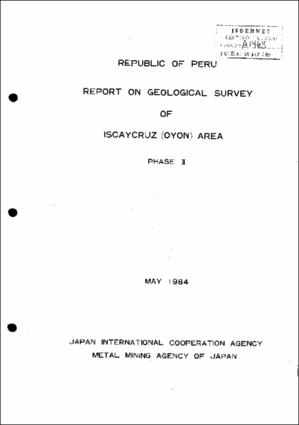- Repositorio Institucional INGEMMET
- Estudios e Informes técnicos
- Estudios y trabajos de investigación
Please use this identifier to cite or link to this item:
https://hdl.handle.net/20.500.12544/4466Report on geological survey of Iscaycruz (Oyon) area: Phase II
May-1984
This report summarizes results of the second year's work of the Cooperative Basic Geological Survey for Development of Mineral Resources carried out in the Iscaycruz Area, the Republic of Peru. The purpose of this project is to examine relationship between geological structure and mineralization, and to confirm lateral and vertical continuity of the mineralized zone, by means of drilling exploration and tunnelling exploration in this area. The Iscaycruz Area had been extracted as a favorable area where economic ore deposits would be expected to be emplaced, by the results of the Cooperative Basic Geological Survey for Development of Mineral Resources in the Oyon Area, which was carried out during the period of three years from 1979 to 1981. The Iscaycruz Area is located about 150 km north of Lima, in the backbone range of the West Andes. Geologically, Mesozoic sedimentary rocks are widely distributed in this area, forming remarkable com posit folded structure due to tight forlding with the axes in the Andean direction, namely NNW-SSE. The Iscaycruz mineralized zone is located approximately 7 km south-southeast of Oyon1 in the high mountain at the altitude of 4,700 m above sea level. The mineralization occurs in the limestones of the Santa Formation, about 50 to 100 meters in thickness, and continues about 12 km along the strike. In this mineralized zone, ore deposits are divided roughly into two categories; the one is contact metasomatic skarn type ore deposits represented by copper-zinc skarn orebodies and the other is hydrothermal replacement ore deposits represented by copper-lead-zinc massive sulphide ore bodies as well as by disseminated orebodies of lead and zinc in the siderite beds. The investigations in the present year, following the works in the last year, the tunneling exploration (Adit-N main tunnel, Adit-N crosscut, Adit-S main tunnel, total excavation length 680 m) and the underground diamond drilling (2 drill sites, 4 holes, total drill length 910 m) were carried out in the Limpe area in the central part of the lscaycruz mineralization zone, where the emplacement of high grade copper-lead-zinc massive sulphide ore deposits would be expected most favorably in the Iscaycruz mineralization zone. By the results of the tunnelling exploration, both main tunnels of Adit-N (4,690 meters above sea level) and Adit-S (4,570 meters above sea level) are located in quartzite of the Chimu Formation. The Santa Formation is recognized over 80 meters along the crosscut of the Adit-N and, in addition to the intense mineralization mainly of pyrite, indications of high grade zinc mi neralization of Zn l 7.13% in average of the true width of l 2 meters are confirmed on the horizon of the hanging-watt-side orebody. By the results of the underground diamond drilling, heavy pyrite mineralization was recognized in 4 holes respectively. By the drill hole JC-6, which was located in the north of the crosscut of the Adit-N, indications of high grade zinc mineralization (core length 7.0 m , Cu 0.32%, Zn 21.59%) and copper disseminations in pyrite mass (core length 7.8 m, Cu 2.48%, Zn 0.46%) were recognized in the peripheral zone of the massive pyrite orebody along the horizon of the footwalt- side orebody. And it has been clarified that there would be intimate relation between the pyrite mineralization and the copper-lead-zinc mineralization.
Japan International Cooperation Agency | Metal Mining Agency of Japan
120 páginas
Files in This Item:
| File | Description | Size | Format | |
|---|---|---|---|---|
| JICA-1984-Report_geological_survey_Iscaycruz-Phase2.pdf | Reporte | 4.61 MB | Adobe PDF | View/Open |
This item is licensed under a Creative Commons License












